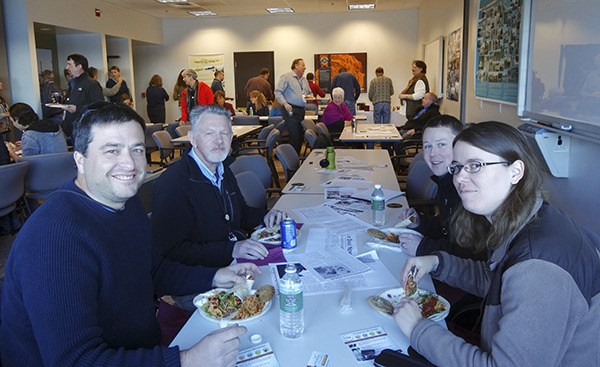As the sole marine research laboratory for the U.S. Department of Energy, the staff at Pacific Northwest National Laboratory’s Marine Sciences Laboratory in Sequim celebrated five decades of ongoing science and research last week.
Although the Marine Sciences Laboratory wasn’t incorporated into PNNL until 1974, PNNL was established in 1965 – thus marking the national lab’s 50th anniversary.
To celebrate the years of collaboration between PNNL staff at the lab’s headquarters in Richland and staff at the marine lab, a celebratory lunch was held Wednesday, Nov. 12, and both PNNL director Mike Kluse and Julie Erickson, representing the Department of Energy’s Pacific Northwest Site Office, which oversees PNNL, visited the Sequim-based facility.
“The Marine Sciences Laboratory in Sequim is essential to PNNL’s strategy to perform the cutting edge science that PNNL is known for and increase its impact to the nation,” Erickson said. As DOE’s only marine research laboratory, we recognize the Marine Science Laboratory as an important asset to DOE and the nation.”
Located along Sequim Bay, the Battelle-owned property since offers a small amount of beach access and about 140 acres of tidelands and Travis Spit. Originally, officials with Battelle bought property in all four corners of the U.S. in order to best foster their mission of “science for the benefit of mankind,” Brandt said. Battelle officials bought the property near Sequim Bay in 1966, and the facility became a working laboratory by 1969.
Although Brandt is not sure why Battelle officials were drawn to the Sequim area, the area’s unique characteristics have been a benefit. Both the “incredible” air quality and bay’s water chemistry being so similar to the Strait of Juan de Fuca help to make the lab an ideal location for sensitive research, such as “ultratrace chemistry” studies where researchers are identifying elements at very low levels, he said.
“For many different reasons there is a lot of chemistry that goes on here and we take advantage of the area’s characteristics,” Brandt said. “We don’t have to build a multi-million dollar facility to create a clean environment to do research because it’s already here.”
Neither the lab in Richland nor the Marine Science Laboratory are doing what they were doing a decade ago – reflecting the constant evolution of PNNL.
The function of a national lab is to address national needs, Brandt said, and those needs change. Although PNNL staff still are involved in nuclear energy and waste research that persists from the lab’s ongoing interaction with the past nuclear production complex in Hanford, the lab’s attention is spread across a wide spectrum of national topics. Additional areas of interest include a growing emphasis on climate change research, renewable energy, improvement of hydropower systems to benefit salmon populations and recently at the Marine Sciences Laboratory researchers have begun to explore the potential of mining rare minerals from seawater, such as uranium ore.
The skills of PNNL and PNNL’s Marine Sciences Laboratory staff have contributed to countless national milestones and occurrences. Some examples include the analysis of lunar material collected from the Apollo program, ecological assessment and other studies to gauge the success of cleanup activities following the Exxon Valdez oil spill, development of super-plastic-forming technology to meet new mileage emissions and recycling goals and the development of one of the first climate models that analyzed global warming’s potential impacts to a region’s agriculture, recreation, water resources and salmon stocks.
“We always cut across all disciplines,” Brandt said. “Bringing together a multi-disciplinary approach enables this lab to have the impact that it does.”
In order to operate the Marine Sciences Laboratory it requires the employment of about 70 people in Sequim, 12 people in Seattle, one person in Oregon and one person in Washington, D.C.
In addition to the lab’s economic impact on Sequim through job creation, Brandt said, one of the lab’s biggest roles within the community is education. Though it’s a fairly restrictive program, the lab offers high school internships and also hires a large amount of locals that have returned after completing their education elsewhere or are in the midsts of it.
“I am extremely proud of the exceptional staff at the Marine Sciences Laboratory and the impact that they are making day in and day out on the challenges facing our nation,” Kluse said. “The Marine Sciences Laboratory in Sequim is absolutely critical to the future of PNNL. It is a unique and valuable resource and its staff are an integral part of our team.”



